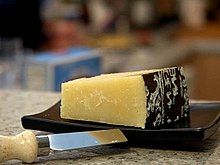
Calcagno is an Italian type of pecorino cheese prepared using raw sheep's milk and peppercorns. [1] [2] [3] It is a hard cheese that can be grated. [4] In its preparation, peppercorns are added to the curd, the mixture is drained in baskets, salt is added, and the mix is aged for at least three months. [1] As the cheese ages, it becomes grainier in texture, and its flavor becomes spicier, pungent and saltier. [1] Calcagno originated in Sardinia, and is prepared in Sardinia and Sicily. [1] [2] It is sometimes aged for up to ten months. [1]